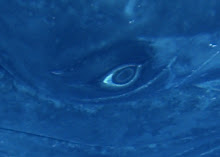Tuesday, May 15, 2012
Latest Report on Dolphin Mortality in Peru
by Hardy Jones and Dr. Carlos Yaipen Llanos
Photo is Dr. Carlos Yaipen Llanos with Ecological Police Officer (c) ORCA.
I've just received the latest report from Dr. Carlos Yaipen Llanos of ORCA Peru on the Mass Mortality Event MME along the coast of northern Peru.
In his last report to BlueVoice he stated acoustical trauma to be the cause of the MME. He does not identify the cause of this trauma. I should note that some experts on MMEs are skeptical of the diagnosis of acoustical trauma because of the extensive area and length of time over which the MME took place. See http://hardyjonesdolphins.com/blog.html
Here are the important elements from Dr. Yaipen Llanos' report. Note in paragraph three the reference to hunting dolphins for food.
By April 13th, ORCA found 53 “new” carcasses of long beaked common dolphins and 6 “new” carcasses of Burmeister’s porpoises that we didn’t count in the previous expedition. We identified “new carcasses” because of their position next to the ocean, the fresh condition of the skin and blubber, and the freshness of the internal organs. Unfortunately for our diagnosis purposes, 90% of them were moderately decomposed due to the action of ocean upon the bodies. These characteristic is also associated to the fact that all dolphins died off-shore.
The field difficulties and the body condition of the stranded dolphins made our work difficult, especially when looking for viable-fresh samples. However, we managed to collect samples from 14 dolphins and 1 porpoise, a total of 55 tissues for analysis including periotic bones, mandibular blubber, and internal organs. Brain was successfully collected from a recently stranded newborn porpoise. Blood from two specimens were only viable on site for serology analysis, but blood did not make it back to our home base in Lima due to the condition of the carcasses, and the difficulties to return.
As part of the research, we decided to do “control surveys”, on April 14th and April 24th to assess dolphin presence in the beaches of San Jose fishermen town and surroundings (10 Km). We found the carcasses of seven dolphins with evidence of “harvesting”, meaning that they caught off-shore to be slaughtered for human consumption. Despite these dolphin carcasses were fresh, it was a fishermen we paid as guide named “Jose Luis” that took us to the “burial sites”. We found juveniles and adults. These dolphins were stabbed by fishermen in boats and the meat collected for consumption. We checked on the “harvested” dolphin carcasses for samples, however, we found no tissues (all were consumed) but we found intact periotic bones, (with no fractures), so it was a good “control” sample to compare with previously collected (and fractured) ones.
Subscribe to:
Post Comments (Atom)


No comments:
Post a Comment